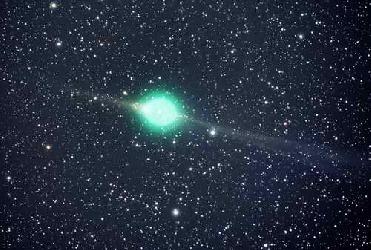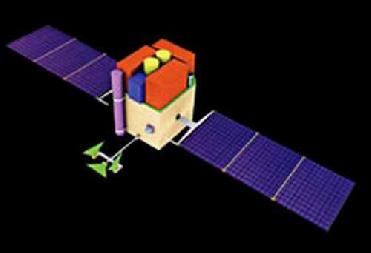
Amateur astronomer Jack Newton sent this photo to NASA
WASHINGTON (BNS): All of you interested in setting up a date with Green Comet Lulin, set your alarms for 3 am on Friday when the Comet approaches the Earth.
The comet rises a few hours before the sun and may be found about 1/3rd of the way up the southern sky before dawn. On Friday, Comet Lulin glides by Zubenelgenubi, a double star at the fulcrum of Libra's scales. Zubenelgenubi is not only fun to say (zuBEN-el-JA-newbee), but also a handy guide. One can see Zubenelgenubi with a naked eye, as it is about as bright as stars in the Big Dipper; but binoculars pointed at the binary star reveal Comet Lulin in beautiful proximity.
If one misses viewing Green Comet on Friday, view it on February 16 or February 24. On February 16, Comet Lulin passes Spica in the constellation Virgo. Spica is a star of first magnitude and a guidepost even city astronomers cannot miss. A finderscope pointed at Spica will capture Comet Lulin in the field of view, centering the optics within a nudge of both objects.
On February 24, the closest it is visible, Lulin will lie just a few degrees from Saturn in the constellation Leo. Saturn is visible to the unaided eye, and Lulin could be as well.
This appears to be Lulin's first visit to the inner solar system and its first exposure to intense sunlight. Hence surprises are possible.
Lulin’s green colour comes from the gases that make up its Jupiter-sized atmosphere. Jets spewing from the comet's nucleus contain cyanogen (CN: a poisonous gas found in many comets) and diatomic carbon (C2). Both substances glow green when illuminated by sunlight in the near-vacuum of space.
Quanzhi Ye, at the age of seven discovered a comet of flamboyant beauty, bright and puffy with an active tail. But two men Hale and Bopp defeated him in the discovery only determining his resolve to find another one. Eleven years later, at the age of 19, Ye, a meteorology student at China's Sun Yat-sen University, while observing an image taken by Taiwanese astronomer Chi Sheng Lin on "sky patrol" at the Lulin Observatory, suddenly stopped. He soon realised that one of the stars was not a star, it was a comet, and this time Ye saw it first.
Comet Lulin, named after the observatory in Taiwan where the discovery-photo was taken, is now approaching the Earth. “It is a green beauty that could become visible to the naked eye any day now,” Ye said.
Scientists said that in 1910, many people panicked when astronomers revealed Earth would pass through the cyanogen-rich tail of Comet Halley. The false alarm was that the wispy tail of the comet couldn't penetrate Earth's dense atmosphere; even it if had penetrated, there wasn't enough cyanogen to cause real trouble. However, Comet Lulin will cause even less trouble than Halley did. At closest approach in late February, Lulin will stop 38 million miles short of Earth, utterly harmless. So star gazers, get ready for the treat.
 Previous Article
Previous Article Next Article
Next Article












The Indian Air Force, in its flight trials evaluation report submitted before the Defence Ministry l..
view articleAn insight into the Medium Multi-Role Combat Aircraft competition...
view articleSky enthusiasts can now spot the International Space Station (ISS) commanded by Indian-American astr..
view article